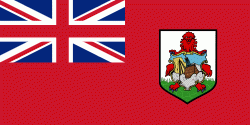St. George's (Saint George)
Bermudian convention, where a toponym contains the name of a person, is to render the person's name in the possessive form. The place is rarely treated as equivalent to the person.
Among many examples of such place names in Bermuda are St. David's Island, Bailey's Bay, Smith's Parish (named for aristocrat Sir Thomas Smith), Sandys' Parish (named for Sir Edwin Sandys), Skeeters' Island (often mistakenly rendered "Skeeter's Island", it is named for Edward Skeeters and is also known as Burt's Island), Gibb's Hill, Barr's Bay, Ackermann's Hill, Nelly's Island, Cooper's Island, Darrell's Island, Paynter's Vale, Abbot's Head (or Abbot's Cliff), and Fort St. Catherine's (on St. Catherines Point). The possessive form is also used for titles, as with Collector's Hill (named for the Collector of Taxes). Maps of Bermuda have most often been produced by non-Bermudians and names given on them do not always conform to Bermudian practice.
The use of the possessive form is not exclusive, however, as exemplified by place names such as the names of most of the parishes (which – other than St. George's Parish – all commemorate historical people), such as Hamilton Parish (named for James Hamilton, 2nd Marquess of Hamilton), Devonshire Parish (named for William Cavendish, 1st Earl of Devonshire), and Paget Parish. Some of these exceptions may have originated with changed syntax, as Devonshire Parish may originally have been The Parish of Devonshire. This is seen with the City of Hamilton (named for Henry Hamilton, a former Governor of Bermuda). Whereas the City of Hamilton is commonly referred to as Hamilton, The Town of St. George, St. George's Parish, St. George's Island, and St. George's Harbour (and any other toponym usually containing a person's name in the possessive form) always remains possessive when shortened, such as in the St. George's Foundation.
By example, Bermudians will always say St. George's and St. David's are the largest islands in St. George's Parish, and never St. George and St. David are the largest islands in St. George Parish. As many maps and other printed materials featuring Bermuda are produced abroad, it is extremely common to find maps, books and other material using the non-possessive forms, but visitors to Bermuda should be aware that using the non-possessive forms when speaking to Bermudians is likely to cause as much offence as saying "Bermudan" (although Bermudians, who pride themselves on politeness, are unlikely to respond rudely).
Map - St. George's (Saint George)
Map
Country - Bermuda
 |
 |
Bermuda is named after Spanish explorer Juan de Bermúdez, who discovered the archipelago in 1505. The islands have been permanently inhabited since 1612, and, forming part of British America, became a crown colony in 1684. The first African slaves arrived in 1616, but as the slave trade ceased by the end of the 17th century, the colony developed into a base for merchants, privateers, and the Royal Navy. More recently, tourism has been a significant contributor to Bermuda's economy. After World War II the territory became an offshore financial centre and tax haven.
Currency / Language
| ISO | Currency | Symbol | Significant figures |
|---|---|---|---|
| BMD | Bermudian dollar | $ | 2 |
| USD | United States dollar | $ | 2 |
| ISO | Language |
|---|---|
| EN | English language |
| PT | Portuguese language |















